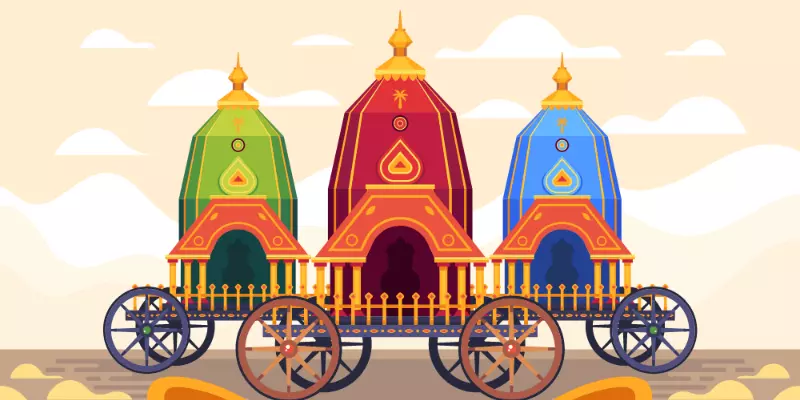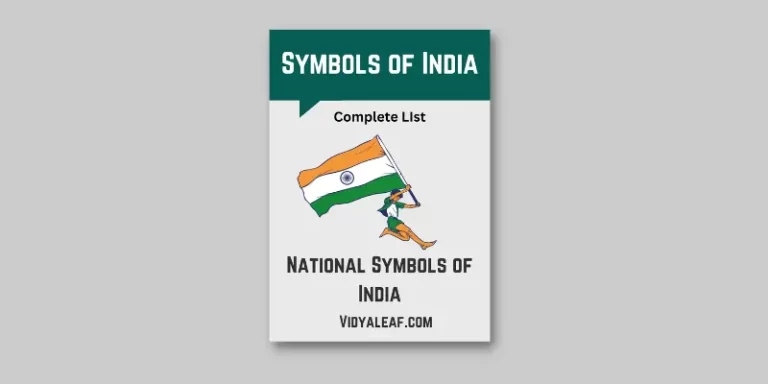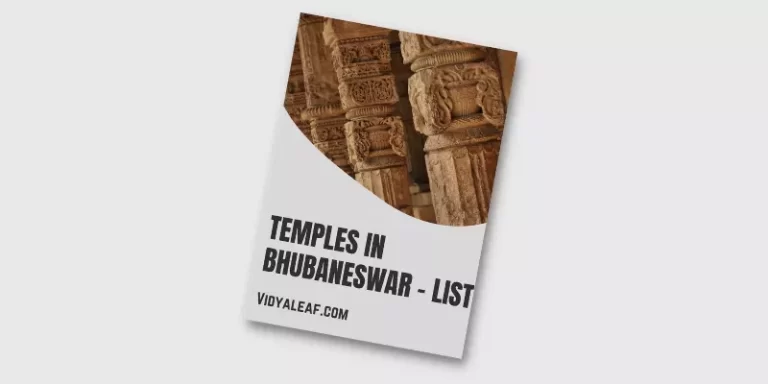Odisha is one of the 30 states in India. It is the 9th largest state of India, is known for its tribal cultures and its many ancient Hindu Temples. The state has an area of 155,707 km2, Odisha is located in the northeastern part of India, facing the Bay of Bengal. Odisha is surrounded by West Bengal, Jharkhand, Chhattisgarh, and Andhra Pradesh. Long ago Odisha was a part of Bihar. Read: Food of Odisha
It got recognition as a new state on 1 April 1936 During the British period. Till 1948, Cuttack served as the capital of Odisha. After that, the temple city Bhubaneswar became the capital of Odisha.
The foundation day of Odisha is also known as “Utkal Divas”. It is celebrated every year on the 1st day of April. The capital city, Bhubaneswar is the largest city of Odisha and Bhubaneswar was the 1st smart city of India.
Quick Facts of Odisha
| Capital | Bhubhaneshwar |
| No. of District | 30 |
| Date of formation | 15/08/47 |
| Governor | Ganeshi Lal |
| Chief Minister | Naveen Patnaik |
| Legislature | Unicameral (147 seats) |
| Parliamentary constituency | 21 Lok Sabha, 10 Rajya Sabha High |
| High Court | Odisha High Court, Cuttack |
| Website | www.odisha.gov.in |
| Tourist attractions | Sun Temple, Konark, Puri, Taptapani |
| Festivals | Rathyatra, Dol Jatra, Patua Jatra, Chandak Puja |
| Major dance and music forms | Odissi, Chitrapada, Dhrubapada, Panchal |
| Arts and crafts | Pattachitras or palm-leaf Ganjifa cards; intricate combs made using bamboo, and fabric; Sambalpuri double ikat. |
| Languages | Odia |
| Size | 155,707 sq. km |
| Population (Census 2011) | 41974218 |
| Rivers | Mahanadi, Baitarani, Brahmani, Tel, and so on |
| Forests and wildlife sanctuaries | Chilka Lake Sanctuary, Simlipal NP, Bhitarkanika WS |
| State animal | Sambhar |
| State bird | Indian Roller |
| State flower | Ashoka |
| State tree | Indian Fig tree |
| Major crops | Paddy, wheat, ragi, maize |
| Factoids | The 33 sandstone caves on the Udaygiri and Khandagiri hills in Bhubaneshwar were probably carved under King Kharavela. |
Area and Population of Odisha
The total area of the state is 155,707 km 2(60,119 sq. mi). According to the 2011 census, the population of Odisha is 41,974,218. The state is the eleventh biggest state in India in terms of population and it holds the eighth rank in the area.
Demographic features of Odisha
About 50.54% of the population of Odisha is male (21,212,136) and 49.46% of the population is female (20,762,082). The density of the population in Odisha is 269/km2. About 94.35% of the population is Hindus, 2.07% are Muslims,2.44% are Christian and only 1.14% are represented by other communities.
The official language of the state is Odia. Other languages such as Hindi, Bengali, Santali, Telugu are spoken in the state. As per the 2011 census, the literacy rate is 72.9%.
District of Odisha
| No. | District | Area | Population | Head Quarters |
|---|---|---|---|---|
| 1 | Angul | 6,376 | 1,273,821 | Angul |
| 2 | Boudh (Baudh) | 3,098 | 441,162 | Boudh |
| 3 | Balangir | 6,575 | 1,648,997 | Balangir |
| 4 | Bargarh | 5,837 | 1,481,255 | Bargarh |
| 5 | Balasore (Baleswar) | 3,806 | 2,320,529 | Balasore |
| 6 | Bhadrak | 2,505 | 1,506,522 | Bhadrak |
| 7 | Cuttack | 3,932 | 2,624,470 | Cuttack |
| 8 | Deogarh (Debagarh) | 2,940 | 312,520 | Deogarh |
| 9 | Dhenkanal | 4,452 | 1,192,811 | Dhenkanal |
| 10 | Ganjam | 8,206 | 3,529,031 | Chhatrapur |
| 11 | Gajapati | 4,325 | 577,817 | Paralakhemundi |
| 12 | Jharsuguda | 2,114 | 579,505 | Jharsuguda |
| 13 | Jajpur | 2,899 | 1,827,192 | Jajpur |
| 14 | Jagatsinghapur | 1,668 | 1,136,971 | Jagatsinghapur |
| 15 | Khordha | 2,813 | 2,251,673 | Khordha |
| 16 | Keonjhar (Kendujhar) | 8,303 | 1,801,733 | Keonjhar |
| 17 | Kalahandi | 7,920 | 1,576,869 | Bhawanipatna |
| 18 | Kandhamal | 8,021 | 733,110 | Phulbani |
| 19 | Koraput | 8,807 | 1,379,647 | Koraput |
| 20 | Kendrapara | 2,644 | 1,440,361 | Kendrapara |
| 21 | Malkangiri | 5,791 | 613,192 | Malkangiri |
| 22 | Mayurbhanj | 10,418 | 2,519,738 | Baripada |
| 23 | Nabarangpur | 5,291 | 1,220,946 | Nabarangpur |
| 24 | Nuapada | 3,852 | 610,382 | Nuapada |
| 25 | Nayagarh | 3,890 | 962,789 | Nayagarh |
| 26 | Puri | 3,479 | 1,698,730 | Puri |
| 27 | Rayagada | 7,073 | 967,911 | Rayagada |
| 28 | Sambalpur | 6,624 | 1,041,099 | Sambalpur |
| 29 | Subarnapur (Sonepur) | 2,337 | 610,183 | Sonepur |
| 30 | Sundargarh | 9,712 | 1,830,673 | Sundargarh |
Government of Odisha
The Chief Minister of the state is Naveen Patnaik at present. The governor of the state is Ganeshi Lal. There are 147 seats in the Legislative Assembly (Vidhan Sabha) of the state. The legislative assembly of Odisha is unicameral. The apex court of the state is the Odisha High Court in Cuttack.
Geographical features of Odisha
It forms a part of the eastern seacoast of India. The shoreline of the state is comparatively undisturbed and the length of this shoreline is approximately 485km. Physiographically the state is divided into the following areas:
The hilly and upland areas in the center. It is a part of the Indian peninsula with deep and broad valleys cut by the rivers. The region is so fertile, well-drained, and thickly populated. The shoreline flatland to the east.the undulating highland to the west. The flat terrains in the middle. The important flood basins.
Rivers of Odisha
The major rivers of Odisha are as follows: The major rivers of Odisha are Mahanadi( longest river of the state ), Kathajodi, Brahmani, Baitarani, Budhabalanga, Rushikulya, Vanmadhara, Nagavali, Kolab, Indravati, Tej rivers. Besides, there are several scenic lakes in the state that are top tourist draws such as Chilika lake, Pata lake, Anshupa lake, Indravati dam, Hirakud dam.
The economy of Odisha
The state has a strong economy with plenty of natural resources and extensive shoreline. Odisha is rich in natural resources like coal, bauxite, iron ore, chromites. Steel manufacturing is a major industry in the state of Odisha. Other industries such as transportation, Oil refinery, power, information technology, aluminum are also major in the state.
Educational institutions of Odisha
List of names of some popular educational institutes in the state of Odisha is the Biju Patnaik University of Technology at Rourkela, Berhampur University at Berhampur, C.V Raman College of Engineering Bhubaneswar, Central University of Odisha Koraput, IIT BBSR at Bhubaneswar, Fakir Mohan University at Balesore, National Institute of Science and Technology at Berhampur, KIIT University in Bhubaneswar, National institute of technology Rourkela at Rourkela.
National Institute of Science Education and Research Bhubaneswar, National Law University Odisha in Cuttack, Ravenshaw University in Cuttack, Odisha University of Agriculture and Technology in Bhubaneswar, Sikhsha O Anusandhan University, Sambalpur University, Sambalpur, Sri Jagannath Sanskrit University of Puri, Silicon Institution of Technology, MKCG Medical College Berhampur, Govt ayurvedic College Bolangir, SCB Dental College in Cuttack, SCB Medical College in Cuttack, Veer Surendra Sai Medical College Burla, Sri University in Cuttack, Utkal University of culture at Bhubaneswar, Utkal University at Bhubaneswar, Veer Surendra Sai University of Technology, Burla Vedanta University.
Tourist attractions in Odisha
The top tourist attractions in Odisha are as follows: The Lingaraj temple at Bhubaneswar, Chilika lake, Daringbadi(Darjeeling of Odisha), Pipli, the Sun temple at Konark, Jagannath temple(puri), Udayagiri and Khandagiri caves, Gharial sanctuary at Tikambapani, Ambapani wildlife sanctuary, Bhitarkanika National park, Nandankanan National park, Sunabeda wildlife sanctuary, Belghar wildlife sanctuary, Chandaka Elephant Reserve, Ushakothi or Badarama wildlife sanctuary, Chilika wildlife sanctuary, Satkosia George wildlife sanctuary, Gahirmatha turtle sanctuary, and Similipal National park.
The well-known Shiva temple is closely located in Dhenkanal. The famous Sea beaches such as Gopalpur-on-sea, Puri, Ramachandi, Chandipur, Astaranga, Pradeep beaches are popular tourist attractions.
Odissi – Dance of Odisha

The caves of Udayagiri: Khandagiri provide some of the earliest examples of Odissi dance. The dance form derives its name from the ‘Odra nritta mentioned in Natya Shastra. In the mid-twentieth century, Odissi gained international acclaim due to the efforts of Charles Fabri and Indrani Rehman. Some of the facts of Odissi are:
- It is similar to Bharatnatyam In the use of Mudras and postures to express emotions.
- The Tribhanga posture, i.e. the three-bended form of the body is innate to Odissi dance. Also, the ‘Chowk’ posture with hands spread out depicts masculinity.
- During the dance, the lower body remains largely static and there is the movement of the torso. Hand gestures play an important role to convey expressions during the Nritya part.
- Odissi’s dance form is unique in its representation of gracefulness, sensuality, and nice beauty. The dancers create intricate geometrical shapes and patterns with her body. Hence, it is known as ‘mobile sculpture’.
Famous Proponents: Guru Pankaj Charan Das, Guru Kelu Charana Mohapatra, Sonal Mansingh, Sharon Lowen ( USA), Myrla Bravie ( Argentina )
Shree Jagannath Temple, Puri

The Jagannath temple of puri is a popular Hindu temple of Lord Jagannath, a form of Lord Vishnu. The temple was built by king Anatavarman Chodaganga in the twelve century. The Puri temple is famous for its annual Ratha yatra.
In this festival, three deities are placed on huge and elaborately decorated temple cars and pulled. Jagganath, Balabhadra, Subhadra are three deities worshipped at that temple including statues of Sudarshan Chakra, Madanmohan, etc.
Inside the temples contains statues of these three gods carved from a sacred neem tree known as Daru sitting on a jeweled platform, Ratnabedi. The deities are adorned with different clothes in different seasons.
The Nila Chakra is present on top Sikhar of the Temple. The flag present on the Nila Chakra is distinct from Sudarshan Chakra which has been placed inside the temple. The Singhdwara or Lion gate is one of the four gates to the temple and forms the main entrance.
The gate face east opening on the top of the Bada danda. The Baisi Pahacha or twenty-two steps leads to the temple complex. An idol of Jagannath known as Patitapavana is painted on the right side of the entrance.
The statue of goddess Lakshmi is carved at the top of the door. A pillar known as Aruna Stambha stands in front of the gate. Many devotees from different countries come here to get the blessing of Lord Jagannath.
Konark Sun Temple

Konark Sun temple is a thirteen century CE Sun Temple at Konark from puri. The temple was built by king Narasingha deva dedicated to the Hindu sun god Surya. This pilgrimage site for Hindus is located near Chandrabhaga.
The name Konark is derived from “Kona” and “Arka”. Kona means corner refers to the Southwest location of this temple and Arka refers to the Hindu god Surya. Sun temple at Konark is also known as Black Pagoda as the first ray of the sun entered the Garbhagriha.
The Konark temple represents this iconography on a grand scale. It has 24 elaborately carved stone wheels which are nearly 12 feet in diameter and is pulled by a set of 7 horses. When viewed from land during sunrise and sunset the temple appears to emerge from the depth of the blue sea carrying the sun.
Bhubaneswar – Capital City of Odisha

Bhubaneswar is an ancient city in India’s eastern state of Odisha. The city historically was named Ekamra Kshetra. Although the modern city of Bhubaneswar was established in 1948, the history of the present-day city can be traced to the third century BCE. It is a confluence of Hindu, Buddhist, Jain heritage.
Bhubaneswar is often referred to as the temple city of India. The Kalinga architecture, with Puri and Konark, forms the “Swarna Tribhuja” or Golden triangle. It is one of the modern cities in India. Bhubaneswar and Cuttack are often called twin cities of Odisha.
Many temples built from sandstone are dotted around Bindu Sagar lake including the most famous Lingaraj Temple. Many sculptures, weaponry, remains of plants and animals and indigenous Patta Chitra paintings fill the Odisha State Museum. The city never forgets a second of time to attract people towards it.



